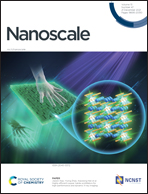Constructing epitaxially grown heterointerface of metal nanoparticles and manganese dioxide anode for high-capacity and high-rate lithium-ion batteries†
Abstract
Low ion migration rate and irreversible change in the valence state in transition-metal oxides limit their application as anode materials in Li-ion batteries (LIBs). Interfacial optimization by loading metal particles on semiconductor can change the band structure and thus tune the inherent electrical nature of transition-metal oxide anode materials for energy applications. In this work, Au nanoparticles are epitaxially grown on MnO2 nanoroads (MnO2–Au). Interestingly, the MnO2–Au anode shows excellent electrochemical activity. It delivers high reversible capacity (about 2–3 fold compared to MnO2) and high rate capability (740 mA h g−1 at 1 A g−1). The electron holography and density functional theory (DFT) results demonstrate that the Au particles on the surface of MnO2 can form a negative charge accumulation area, which not only improves the Li ion migration rate but also catalyzes the transition of MnOx to Mn0. This study provides a direction to heterointerface fabrication for transition-metal oxide anode materials with desired properties for high-performance LIBs and future energy applications.



 Please wait while we load your content...
Please wait while we load your content...